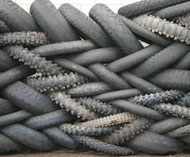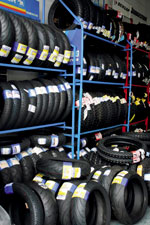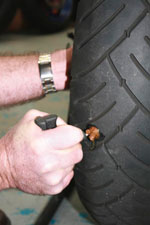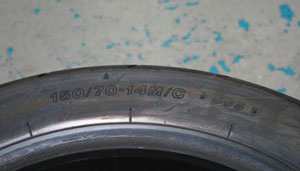
Mmm, donuts
There’s nothing more important to your safety as your choice of tyres, how you use them and how you maintain them. But we’re all different, so how can you decide what’s right for you? Needless to say our tame wrench, Brian Connor, has strong views on the subject.
Most of us, by definition, are somewhere about the middle of the pack in riding ability and only in rare delusional moments imagine we’d give Valentino Rossi a run on the race track.
But that doesn’t mean we’re going to benefit from cutting corners when the day comes to stump up for new tyres. True, we probably wouldn’t benefit much from fitting our rides with the latest gumball supersports tyres but there are plenty of good hoops on the shelves to suit our particular – and, no doubt, peculiar – combinations of ability and requirements, and quality costs money.
It all starts, reckons Brian, with having a chat with the cheery souls at your local workshop. “Many riders don’t know what tyres they’re running but then they don’t have to. Get in good with your local shop and they’ll help you to help yourself. Talk to the bloke who services your bike and you’ll learn plenty of tips and tricks. That’s a good place to start.”
But it helps to have half a clue to begin with. Taken in broad categories, tyres can be divided into supersports, sports, sport-touring and touring categories. Each has its own application, each offers its own particular combination of grip and durability.
“When someone comes to asking for a change of tyre,” says Brian, “our first question comes as we walk over to the customer’s bike: ‘are you happy with what you have?’
“Grip isn’t usually a problem. Most modern tyres give such good grip/mileage that it’s only the harder rider who has a problem – usually the blokes who spend their time riding track days.”
Size
 Conveniently, says Brian, bikes of different types tend to get served with different ranges of tyre sizes. Most cutting-edge sports bikes, for example, these days get served up with 180/55 or 190/50 rears, which would be a tough fit to the business end of a cruiser that’s designed for a 170/80, such as our long-term Triumph Speedmaster.
Conveniently, says Brian, bikes of different types tend to get served with different ranges of tyre sizes. Most cutting-edge sports bikes, for example, these days get served up with 180/55 or 190/50 rears, which would be a tough fit to the business end of a cruiser that’s designed for a 170/80, such as our long-term Triumph Speedmaster.
And it’s generally not a brilliant idea to fool around with tyre sizes too much. Down in my shed there’s a ’90s model naked bike that’s designed to take a 150/70 rear tyre but some owners are starting to use 160/60s and that sort of change can pose problems: the 160/60 is designed for a wider rim than a 150/70 and coaxing one onto a smaller rim can do strange things to the profile of the tyre. Any change of tyre size necessarily alters the working geometry of the bike with consequences for its steering and handling. Stick with the specified sizes.
Balance
Getting your new tyres fitted inevitably means rebalancing your wheels, but it’s not something to get hung up on, reckons Brian. “Modern tyres are so good, so well-balanced that you almost certainly won’t need any little bits of lead.
“For sure, your wheels should be balanced whenever you have new tyres fitted – and the tried and true method of static balancing is still a sound choice.”
Pressure
You’ve got the right tyre on board and you’re about to leave the shop. What now? Heed the tyre man’s words: take it easy for the first few kilometres to remove the thin layer of mould-release compound all tyres leave the factory with.
After that, you’re sitting pretty. You will, with a modicum of good luck, be on the road for a long time before you have to think about replacing either tyre again. Check your pressures periodically, have a look at the treads for anything nasty that might have found its way in and you’ll be right.
How often should you check your pressures? There’s a local legend about a bloke who had tyres fitted by his local dealer, went away happy as a lark but was back some months later complaining about a deterioration in their performance. “What pressures are you running?” the wrench asked him. “Whatever you put in them,” he said.
The message? How often you check your pressures depends on how, where and how much you ride, and on how well your tyres seal at the beads. “Tyres can lose a couple of pounds or more in just a week or two, so you should check them ask often as necessary to ensure your pressures haven’t dropped more than 1-2psi [6.9-13.8kPa, if you absolutely insist].” Too often is better than not often enough and don’t leave it longer than about six weeks between checks.
Check your tyres when cold – keep a tyre pressure gauge handy and check them before you head off on a ride. If you find your pressures are more than a couple of pounds out then your tyres need air.
You need the obligatory “good quality gauge” to check you pressures but Brian reckons the inexpensive pencil gauge we’ve been using for generations is as good as anything you’re likely to find. And if you’re suspicious of the numbers your gauge gives you, compare yours with a few others on the same wheel before your next ride with the troops. One other point – you’ve probably heard it a thousand times before but don’t pin your faith on servo gauges.
What pressures should you run? Use the recommended pressures for your bike as a guide. Talk to those of your mates who have the same bike as you; and certainly talk to the bloke who fits your tyres – he’ll know how you ride from reading your tyre and will be able to help you fix any problems.
Don’t be tempted to vary your pressures more than 1-2psi. It seems some people equate lower pressures with greater grip, presumably believing that as a lump of squidgy Play-Doh sticks pretty well, a nice soft squishy tyre will do likewise. Wrong, so wrong. A soft tyre will not only make your bike handle like the proverbial wheelbarrow full of walruses, it will, reckons Brian, “wear your tyres out and feather the edges that much faster”.
Wear
Brian gets plenty of questions on the subject of wear. He’s most often asked why rear tyres wear in the centre and fronts on the right-hand side. The rear tyre is easily explained: the rear contact patch bears the brunt of the horsepower, so it’s only reasonable to expect that it might wear more quickly than the shoulders of the tyre, which is why one or two tyre manufacturers have invested plenty of research bucks developing tyres on dual-compound tyres that offer improved grip on the edges and still offer durability in the middle.
The front tyre is in some ways the opposite. “Your front does most of its straight-line work when you’re cornering,” Brian explains. “As we ride on the left of the road, the right side of the tyre is up against the camber of the road more of the time than the left and right-hand bends are longer than lefts.”
Round, black – and critical
Get off your bike and walk away without putting it on a stand and it’ll fall over. It’s dynamically unstable. You can’t fall off a car and because of that we have to try harder with safety-related maintenance and that includes tyres. As I said, and will keep saying, check your pressures often and while you’re about it, check the treads for potential problems. All okay? Okay, now you’re set.
Round and flat
A puncture is among the handful of events that are guaranteed to spoil your day. A front puncture is potentially more serious and can land you on your head without ceremony, but either is a pain, even in these days of tubeless tyres.
So there you are: in the middle of nowhere, no centre stand and a rear tyre that looks as if it’s wheezing out its last breath, thanks to the insidious work of a foreign object. What do you do?
The first thing to do is to examine the tyre carefully and find out what’s caused the puncture. If your rear tyre is a modern tubeless unit, resist the temptation to pull out the screw/nail. Instead, check the tyre pressure. If you still have 15-20psi on board you might be able to reach the nearest servo. If, on the other hand, the tyre is flat, there are a couple of options open to you. The first is to plug the tyre using one of the many proprietary puncture repair kits available. These contain all you need to get mobile – plugs, glue, insertion tool and bottles of compressed carbon dioxide to get sufficient pressure into your back tyre to return you to civilisation.
 And then there are the tyre sealants. These are available in pressurised and non-pressurised forms. Motul Tyre Repair, for example, which is suitable for used in tubed or tubeless tyres, is supplied in a pressurised can. The idea is to elevate the wheel, thread the hose onto the valve and squirt the goo into the tyre/tube, which then performs the twin tasks of plugging the puncture and inflating the tyre.
And then there are the tyre sealants. These are available in pressurised and non-pressurised forms. Motul Tyre Repair, for example, which is suitable for used in tubed or tubeless tyres, is supplied in a pressurised can. The idea is to elevate the wheel, thread the hose onto the valve and squirt the goo into the tyre/tube, which then performs the twin tasks of plugging the puncture and inflating the tyre.
Slime, on the other hand, is non-pressurised, but is likewise squeezed into the tyre/tube via the valve. It won’t reinflate the tyre, so you’ll need the use of a foot/hand pump, a portable electric pump or one or more bottle of compressed carbon dioxide of the type supplied with tubeless tyre puncture-repair kits to get you rolling again.
There are several brands of these around and each contains the wherewithal to get you rolling again – plugs, glue, insertion tool and bottles of compressed carbon dioxide to get sufficient pressure into your back tyre.
Brian is very keen on rope plugs. Rope-plug repair kits are freely available, he says, and he’s been using them for years.
“In the kit you get several lengths of string, about the thickness of a drinking straw, pre-impregnated with glue. You grab a plug, poke it in, twist it, pull the tool out, cut the plug to length, inflate your tyre and ride away.
“Everyone should know about rope plugs as an emergency, get-you-home measure,” he says.
If you’re running tubed tyres, several products can help in certain circumstances. Again, these include Motul Tyre Repair and Slime. Otherwise, without an abundance of skill, a good range of tools and plenty of daylight, you’re cactus.
Perhaps the point to consider here is prevention rather than cure. There are several good tyre sealants on the market that will stop a lot of punctures from happening, whatever tyres you have. Slime we’ve already seen, but there are others, including UltraSeal, Puncture Proof or True Blue Puncture Goo.
Whichever product you opt for, make sure you for the manufacturer’s directions for use to the letter. Tyres are a safety issue: always bear that in mind.
“Certainly if I were spending lots of time in the boonies with spoked wheels I’d preseal my tubes,” Brian Connor says.
A final shot of good news for the less massively built rider – it’s not necessary, Brian says, to elevate the wheel when you’re using any of these dodges, so there’s no need to spend long nights laying awake trying to work out how in hell you’re going to fit a centre stand to your R6 (or Harley-Davidson Softail!) before setting out on your next long ride.
Go the numbers
There’s enough information on the sidewalls of your tyres to make a perfectly credible short story – if you know how to read it. Most important  are the large, bold embossed numbers that contain vital information about the size of your tyre, its load and speed ratings. For example, parked in Brian’s shop was a Honda CBR600 whose rear tyre bore the following designation – 160/60 ZR 17 69 (W) – which breaks down like this:
are the large, bold embossed numbers that contain vital information about the size of your tyre, its load and speed ratings. For example, parked in Brian’s shop was a Honda CBR600 whose rear tyre bore the following designation – 160/60 ZR 17 69 (W) – which breaks down like this:
160 – the nominal width of the tyre in millimetres
60 – the nominal aspect ratio, which is the height of the inflated tyre expressed as a percentage of its width
ZR – gives information on the tyre’s construction; R stands for radial, B for bias-belted
17 – the diameter of the wheel in inches
69 – is the load index. The lowest number is 20, which equates to a maximum load of 80kg, the highest is above 80, which gives a permissible loading of 500+kg. It’s a more or less linear index, so a figure of 69 allows a loading of about 340kg
(W) – is the speed rating, which means the tyre is made to withstand speeds of 240+km/h
Different speed ratings are assigned different letters: S, 180km/h; H, 210km/h; V/VR 240km/h.
Okay, Sherlock, your turn. Decipher the information on your own tyres, I dare you. Ah yes, one other point. Somewhere on the sidewall of the tyre you’ll find an arrow. The head should be pointing in the direction of rotation. If you check nothing else, do have a look at that.
